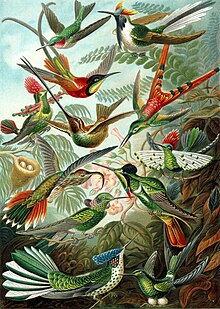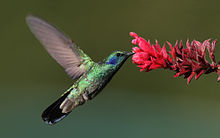
Hi Everybody!!
Within the dark shadows, you find the sweetest light! Time for an update on the Hummingbird Migration 2014 from my location in S. Texas. I counted over 50 this morning! These numbers are down from last year, but I am hopeful more will come in. Again this year, the honeybees are migrating with the birds. The bees have adapted very well to the hummer feeders. Be prepared if you hang feeders that bees are just as likely to come eat. You can not kill the bees while trying to save the birds, so consider your options. I have made friends with the bees and they do not sting me. The hummers and honeys have developed a strange relationship due to human nectar feeders. I am attempting to catch the behaviors in the camera as they fly at warp speed! Today's photostudy was captured at the first of August when the count was 4 and the light was low. Enjoy!









Link to Photo Album:
https://plus.google.com/u/0/photos/117645114459863049265/albums/6052670047449129489

Hummingbird
From Wikipedia, the free encyclopedia
Hummingbirds are New World birds that constitute the family Trochilidae. They are among the smallest of birds, most species measuring in the 7.5–13 cm (3–5 in) range. Indeed, the smallest extant bird species is a hummingbird, the 5-cm bee hummingbird, weighing less than a U.S. zinc penny(about 2.5g).
They are known as hummingbirds because of the humming sound created by their beating wings which flap at high frequencies audible to humans. They hover in mid-air at rapid wing flapping rates, typically around 50 times per second,[1] but possibly as high as 200 times per second, allowing them also to fly at speeds exceeding 15 m/s (54 km/h; 34 mph),[2] backwards or upside down.[3][4]
Hummingbirds have the highest metabolism of any homeothermic animal.[5] To conserve energy when food is scarce, they have the ability to go into a hibernation-like state (torpor) where their metabolic rate is slowed to 1/15th of its normal rate.[6]
Specialized characteristics and metabolism[edit]
With the exception of insects, hummingbirds while in flight have the highest metabolism of all animals, a necessity in order to support the rapid beating of their wings during hovering and fast forward flight.[12][5] Their heart rate can reach as high as 1,260 beats per minute, a rate once measured in a blue-throated hummingbird,[13] with a breathing rate of 250 breaths per minute, even at rest.[14] During flight, oxygen consumption per gram of muscle tissue in a hummingbird is approximately 10 times higher than that seen for elite human athletes.[5]
Hummingbirds consume more than their own weight in nectar each day, and to do so they must visit hundreds of flowers daily. Hummingbirds are continuously hours away from starving to death and are able to store just enough energy to survive overnight.[15]
Hummingbirds are rare among vertebrates in their ability to rapidly make use of ingested sugars to fuel energetically expensive hovering flight, powering up to 100% of their metabolic needs with the sugars they drink (in comparison, human athletes max out at around 30%). One study[16] showed that hummingbirds can use newly ingested sugars to fuel hovering flight within 30–45 minutes of consumption.[17] These data suggest that hummingbirds are able to oxidize sugar in flight muscles at rates high enough to satisfy their extreme metabolic demands. By relying on newly ingested sugars to fuel flight, hummingbirds can reserve their limited fat stores to sustain them overnight fasting or to power migratory flights.[16]
The dynamic range of metabolic rates in hummingbirds[18] requires a corresponding dynamic range in kidney function.[19] The glomerulus is a cluster of capillaries in the nephrons of the kidney that removes certain substances from the blood, like a filtration mechanism. The rate at which blood is processed is called the glomerular filtration rate (GFR). Most often these fluids are reabsorbed by the kidneys. GFR also slows when a bird is undergoing water deprivation. The interruption of GFR is a survival and physiological mechanism unique to hummingbirds.[19]
Studies of hummingbirds' metabolisms are relevant to the question of how a migrating ruby-throated hummingbird can cross 800 km (500 mi) of the Gulf of Mexico on a nonstop flight.[14] This hummingbird, like other birds preparing to migrate, stores fat as a fuel reserve, thereby augmenting its weight by as much as 100% and hence increasing potential flying time over open water.[20][14]
Torpor[edit]
Hummingbirds are capable of slowing their metabolism at night or any time food is not readily available, entering a hibernation-like, deep sleep state known as torpor needed to prevent energy reserves from falling to a critical level. During nighttime torpor, body temperature falls from 40oC to 18oC,[21] with heart and breathing rates both slowed dramatically (heart rate to roughly 50 to 180 beats per minute from its daytime rate of higher than 1000).[22]
During torpor, to prevent dehydration, the kidney glomerular filtration rate ceases, preserving needed compounds like glucose as a source of fuel, water and nutrients.[19] Further, body mass declines throughout nocturnal torpor at a rate of 0.04 g per hour, amounting to about 10% of weight loss each night.[19] The circulating hormone, corticosterone, is one signal that arouses a hummingbird from torpor.[23]
Use and duration of torpor vary among hummingbird species and are affected by whether a dominant bird defends territory, with non-territorial subordinate birds having longer periods of torpor.[24]
Lifespan[edit]
Hummingbirds have long lifespans for organisms with such rapid metabolisms. Though many die during their first year of life, especially in the vulnerable period between hatching and leaving the nest (fledging), those that survive may live a decade or more. Among the better-known North American species, the average lifespan is probably 3 to 5 years. By comparison, the smallershrews, among the smallest of all mammals, seldom live more than 2 years.[25] The longest recorded lifespan in the wild is that of a female broad-tailed hummingbird that was banded (ringed) as an adult at least one year old, then recaptured 11 years later, making her at least 12 years old. Other longevity records for banded hummingbirds include an estimated minimum age of 10 years 1 month for a female black-chinned similar in size to the broad-tailed, and at least 11 years 2 months for a much larger buff-bellied hummingbird.[26]
Diet and specializations for food gathering[edit]
Hummingbirds drink nectar, a sweet liquid inside certain flowers. Like bees, they are able to assess the amount of sugar in the nectar they eat; they normally reject flower types that produce nectar that is less than 10% sugar and prefer those whose sugar content is higher. Nectar is a mixture of glucose, fructose, and sucrose, and is a poor source of nutrients, so hummingbirds meet their needs for protein, amino acids, vitamins,minerals, etc. by preying on insects and spiders.[56]
Hummingbird bill shapes vary dramatically, as an adaptation for specialized feeding. Some species, such as hermits (Phaethornis spp.) have bills that are long allowing them to probe deep into flowers that have a long corolla. Thornbills have short, sharp bills adapted for feeding from flowers with short corollas and piercing the bases of longer ones. The sicklebills' extremely decurved bills are adapted to extracting nectar from the curved corollas of flowers in the familyGesneriaceae. The bill of the fiery-tailed awlbill has an upturned tip, as in the avocets. The male tooth-billed hummingbird has barracuda-like spikes at the tip of its long, straight bill.
The two halves of a hummingbird's bill have a pronounced overlap, with the lower half (mandible) fitting tightly inside the upper half (maxilla). When hummingbirds feed on nectar, the bill is usually opened only slightly, allowing the tongue to dart out and into the interior of flowers.
Hummingbirds drink with their tongue by rapidly lapping nectar. Their tongues have tubes which run down their lengths and help the hummingbirds drink the nectar. While it had been believed that capillary action was what drew nectar into these tubes, high-speed photography has revealed that the tubes open down their sides as the tongue goes into the nectar, and then close around the nectar, trapping it so it can be pulled back into the beak.[57][58] Consequently, tongue flexibility enables accessing, transporting and unloading nectar.[59]
Hummingbirds do not spend all day flying, as the energy cost would be prohibitive; the majority of their activity consists simply of sitting or perching. Hummingbirds eat many small meals and consume approximately half their weight in pure sugar (twice their weight in nectar, if the nectar is 25% sugar) each day.[60] Hummingbirds digest their food rapidly due to their small size and high metabolism; a mean retention time (MRT) of less than an hour has been reported.[61] Hummingbirds spend an average of 10–15% of their time feeding and 75–80% sitting and digesting.
Because they starve so easily, hummingbirds are highly attuned to food sources. Some species, including many found in North America, are territorial and will try to guard food sources (such as a feeder) against other hummingbirds, attempting to ensure a future food supply for itself.
Feeders and artificial nectar[edit]
In the wild, hummingbirds visit flowers for food, extracting nectar, which is 55% sucrose, 24% glucose and 21% fructose.[62] Hummingbirds will also take sugar-water from bird feeders. Such feeders allow people to observe and enjoy hummingbirds up close while providing the birds with a reliable source of energy, especially when flower blossoms are less abundant. A negative aspect of artificial feeders, however, is that the birds may seek less flower nectar for food, and so reduce the amount of pollination their feeding naturally provides.[63]
White granulated sugar is the best sweetener to use in hummingbird feeders. A ratio of 1 part sugar to 4 parts water (20% sugar) is a common recipe,[64]although hummingbirds will defend feeders more aggressively when sugar content is at 35%, indicating preference for nectar with higher sweetness and sugar content.[65] Boiling and then cooling this mixture before use has been recommended to help deter the growth of bacteria and fungi. Powdered sugars contain corn starch as an anti-caking agent which can contribute to premature fermentation of the solution. Brown, turbinado, and "raw" sugars contain iron, which can be deadly to hummingbirds if consumed over long periods.[66] Honey is made by bees from the nectar of flowers, but it is not good to use in feeders because when it is diluted with water, microorganisms easily grow in it, causing it to spoil rapidly.[67][68][69]
Red food dye is often added to homemade solutions, however is not necessary and may be harmful to the birds. Commercial products sold as "instant nectar" or "hummingbird food" may also contain preservatives and/or artificial flavors as well as dyes. The long-term effects of these additives on hummingbirds have not been studied.[70] Although some commercial products contain small amounts of nutritional additives, hummingbirds obtain all necessary nutrients from the insects they eat. This renders the added nutrients unnecessary in most situations.[52]
Other animals also visit hummingbird feeders. Bees, wasps, and ants are attracted to the sugar-water and may crawl into the feeder, where they may become trapped and drown. Orioles, woodpeckers, bananaquits, and other larger animals are known to drink from hummingbird feeders, sometimes tipping them and draining the liquid.[71] In the southwestern United States, two species of nectar-drinking bats (Leptonycteris yerbabuenae andChoeronycteris mexicana) visit hummingbird feeders to supplement their natural diet of nectar and pollen from saguaro cacti and agaves.[72]

...this is brendasue signing off from Rainbow Creek. See you next time! Remember to put out water for your wildlife!

O+O





No comments:
Post a Comment